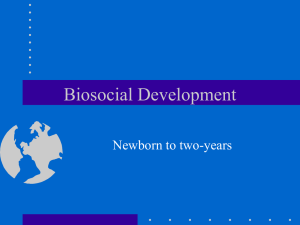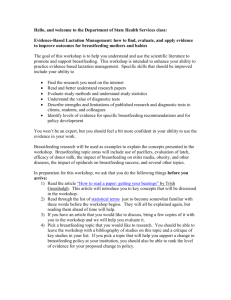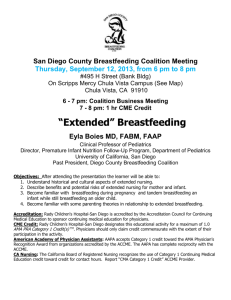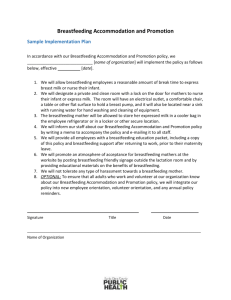In a Disaster or an Emergency
advertisement
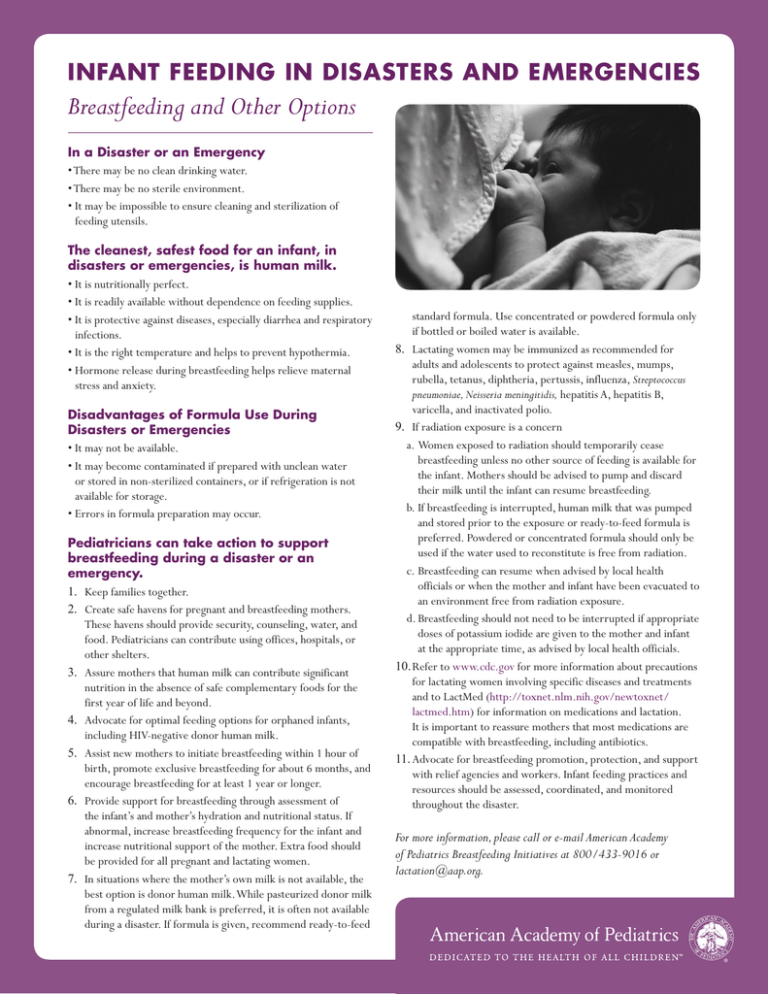
INFANT FEEDING IN DISASTERS AND EMERGENCIES Breastfeeding and Other Options In a Disaster or an Emergency • There may be no clean drinking water. • There may be no sterile environment. • It may be impossible to ensure cleaning and sterilization of feeding utensils. The cleanest, safest food for an infant, in disasters or emergencies, is human milk. • It is nutritionally perfect. • It is readily available without dependence on feeding supplies. • It is protective against diseases, especially diarrhea and respiratory infections. • It is the right temperature and helps to prevent hypothermia. • Hormone release during breastfeeding helps relieve maternal stress and anxiety. Disadvantages of Formula Use During Disasters or Emergencies • It may not be available. • It may become contaminated if prepared with unclean water or stored in non-sterilized containers, or if refrigeration is not available for storage. • Errors in formula preparation may occur. Pediatricians can take action to support breastfeeding during a disaster or an emergency. 1. Keep families together. 2. Create safe havens for pregnant and breastfeeding mothers. These havens should provide security, counseling, water, and food. Pediatricians can contribute using offices, hospitals, or other shelters. 3. Assure mothers that human milk can contribute significant nutrition in the absence of safe complementary foods for the first year of life and beyond. 4. Advocate for optimal feeding options for orphaned infants, including HIV-negative donor human milk. 5. Assist new mothers to initiate breastfeeding within 1 hour of birth, promote exclusive breastfeeding for about 6 months, and encourage breastfeeding for at least 1 year or longer. 6. Provide support for breastfeeding through assessment of the infant’s and mother’s hydration and nutritional status. If abnormal, increase breastfeeding frequency for the infant and increase nutritional support of the mother. Extra food should be provided for all pregnant and lactating women. 7. In situations where the mother’s own milk is not available, the best option is donor human milk. While pasteurized donor milk from a regulated milk bank is preferred, it is often not available during a disaster. If formula is given, recommend ready-to-feed standard formula. Use concentrated or powdered formula only if bottled or boiled water is available. 8. Lactating women may be immunized as recommended for adults and adolescents to protect against measles, mumps, rubella, tetanus, diphtheria, pertussis, influenza, Streptococcus pneumoniae, Neisseria meningitidis, hepatitis A, hepatitis B, varicella, and inactivated polio. 9. If radiation exposure is a concern a.Women exposed to radiation should temporarily cease breastfeeding unless no other source of feeding is available for the infant. Mothers should be advised to pump and discard their milk until the infant can resume breastfeeding. b.If breastfeeding is interrupted, human milk that was pumped and stored prior to the exposure or ready-to-feed formula is preferred. Powdered or concentrated formula should only be used if the water used to reconstitute is free from radiation. c.Breastfeeding can resume when advised by local health officials or when the mother and infant have been evacuated to an environment free from radiation exposure. d.Breastfeeding should not need to be interrupted if appropriate doses of potassium iodide are given to the mother and infant at the appropriate time, as advised by local health officials. 10.Refer to www.cdc.gov for more information about precautions for lactating women involving specific diseases and treatments and to LactMed (http://toxnet.nlm.nih.gov/newtoxnet/ lactmed.htm) for information on medications and lactation. It is important to reassure mothers that most medications are compatible with breastfeeding, including antibiotics. 11.Advocate for breastfeeding promotion, protection, and support with relief agencies and workers. Infant feeding practices and resources should be assessed, coordinated, and monitored throughout the disaster. For more information, please call or e-mail American Academy of Pediatrics Breastfeeding Initiatives at 800/433-9016 or lactation@aap.org. KEY STRATEGY: INCREASING THE CURRENT RATE OF BREASTFEEDING IN THE UNITED STATES IS FUNDAMENTAL TO OPTIMIZE INFANT NUTRITION WHEN DISASTER STRIKES. Breastfeeding Facts 1.Mothers continue to lactate in times of physical and emotional stress but will need support. 2.Malnourished women and women with medical illnesses can breastfeed. 3.Optimal human milk supply is maintained by infant demand. 4.For some mothers and babies, once breastfeeding has stopped, it may be resumed successfully. a.Encourage skin-to-skin contact and frequent suckling (every 2 hours). b.Supply increases gradually over days to weeks and supplementation should decrease accordingly. c.Careful assessment of the infant’s nutritional and hydration status is critical. d.A full milk supply is established more rapidly with the younger infant. e.Mothers need encouragement during this process. For more information on infant feeding during a disaster and relactation technique, please visit the Emergency Nutrition Network (ENN) Initiative, available at www.ennonline.net. INFANT FEEDING IN DISASTERS AND EMERGENCIES Mother and Infant/Child Together Mother and Infant/Child Not Together Mother Breastfeeding Precrisis Mother Not Breastfeeding Precrisis Lactation OK Lactation Reduced/ Interrupted Lactation Possible Lactation Not Possible Breastfeeding Support Relactation Support Donor Human Milk Available Donor Human Milk Not Available Provide Ready-to-Feed Standard Formula Copyright © 2015 American Academy of Pediatrics. All rights reserved. The recommendations in this publication do not indicate an exclusive course of treatment or serve as a standard of medical care. Variations, taking into account individual circumstances, may be appropriate. For more information, please call or e-mail American Academy of Pediatrics Breastfeeding Initiatives at 800/433-9016 or lactation@aap.org.
